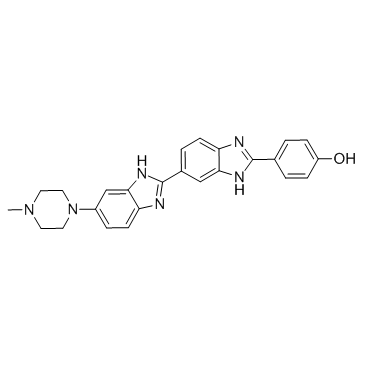23491-44-3
| Name | pibenzimol |
|---|---|
| Synonyms |
4-[5-[6-(4-methylpiperazin-1-yl)-1H-benzimidazol-2-yl]-1,3-dihydrobenzimidazol-2-ylidene]cyclohexa-2,5-dien-1-one
Pibenzimol HCl Pibenzimol Bisbenzimidazole EINECS 245-689-0 Hoechst 33258 |
| Description | Hoechst 33258 is a fluorescent dye that emits blue fluorescence when bound to dsDNA. |
|---|---|
| Related Catalog | |
| Target |
IC50: 51.31±4.56 μM (HeLa cell), 32.43±3.27 μM (HL60 cell), 15.42 ± 2.16 μM (U937 cell)[1] |
| In Vitro | Hoechst 33258, a fluorescent compound with a head-to-tail bis-benzimidazole structure, is initially found to be cytotoxic against L1210 murine leukemia. Hoechst 33258 is evaluated for their cytotoxicity against human tumor cell lines, which are cervix carcinoma cell line (HeLa), Human promyelocytic leukemia cell (HL60) and U937 cell Line. The IC50 determined in the case of HeLa, HL60 and U937 is 51.31±4.56, 32.43±3.27 and 15.42±2.16 μM for Hoechst 33258, respectively[1]. The cytotoxic property of Hoechst 33258 is investigated on a panel of seven tumour cell lines of different histological origin and Madine-Darby canine kidney (MDCK) normal cells. All cell lines, except MCF-7, exposed to Hoechst 33258 exhibit GI50 from 84×10-6 to 191.5×10-6 mol/dm3. Under the same experimental conditions, Hoechst 33258, used as a binder reference compound, stops the cell cycle in S phase and G0/G1[2]. |
| Cell Assay | Hoechst 33258 is prepared as stock solutions in highly pure water. Working solutions in a concentration range of 10-3-10-6 mol/dm3 are prepared prior to testing. Cytotoxic effects of Hoechst 33258 on tested cell lines are determined by the MTT assay. Cells are seeded in 96 micro well flat bottom plates at a concentration of 2×104 cells/mL and left overnight in the CO2 incubator allowing them to attach to the plate surface. Growing medium is replaced with compound supplemented or control medium and incubated for 72 h. Fresh medium with 5 mg/mL of MTT is added onto cells and incubated for 4 h at 37°C. Upon media removal, water insoluble MTT-formazan crystals formed inside the living cells are dissolved in DMSO and the absorbance at 570 nm proportional to the number of living cells is measured on an Elisa Microplate Reader. All experiments are performed at least three times in triplicates.The GI50 value, defined as the compound concentration (μM) leading to cellular growth inhibition by 50%, is calculated and used as a parameter to compare cytotoxicity among the compounds[2]. |
| References |
| Density | 1.337 g/cm3 |
|---|---|
| Boiling Point | 643.1ºC at 760 mmHg |
| Melting Point | 314ºC |
| Molecular Formula | C25H24N6O |
| Molecular Weight | 424.49800 |
| Flash Point | 342.7ºC |
| Exact Mass | 424.20100 |
| PSA | 84.07000 |
| LogP | 4.23350 |
| Vapour Pressure | 0mmHg at 25°C |
| Index of Refraction | 1.742 |
| Storage condition | -20℃ |
CHEMICAL IDENTIFICATION
HEALTH HAZARD DATAACUTE TOXICITY DATAMUTATION DATA
|
| Hazard Codes | Xn: Harmful; |
|---|---|
| Risk Phrases | R22 |
| Safety Phrases | 26-36 |
